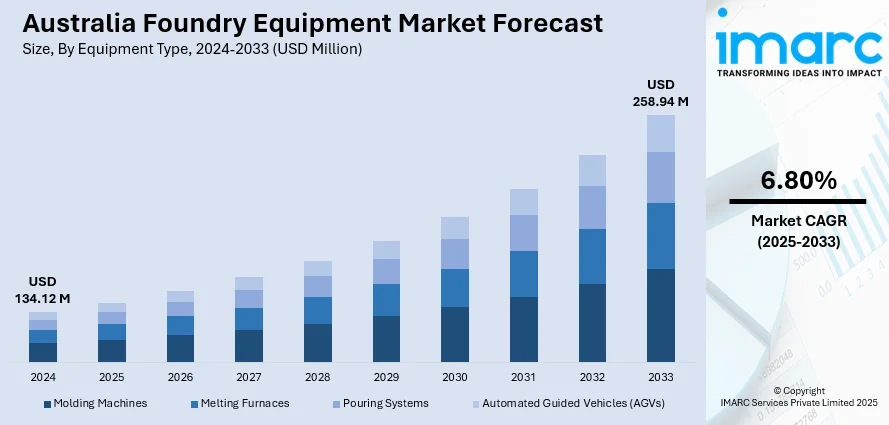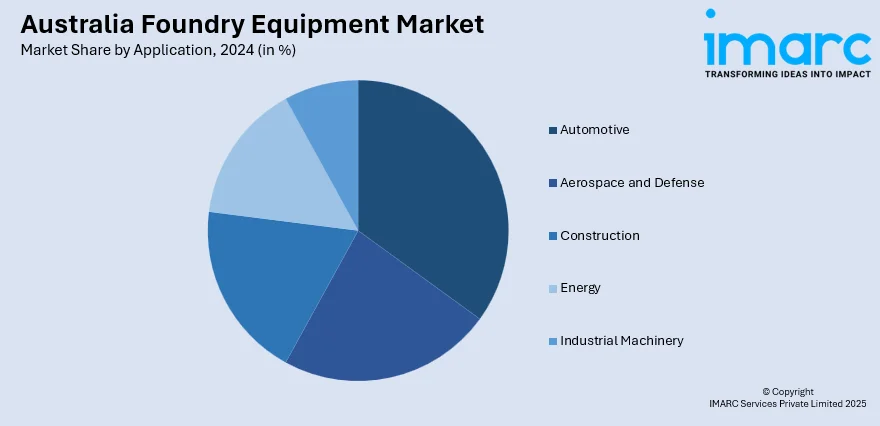
Australia Foundry Equipment Market Size, Share, Trends and Forecast by Equipment Type, Foundry Process, Application, and Region, 2025-2033
Australia Foundry Equipment Market Overview:
The Australia foundry equipment market size reached USD 134.12 Million in 2024. Looking forward, IMARC Group expects the market to reach USD 258.94 Million by 2033, exhibiting a growth rate (CAGR) of 6.80% during 2025-2033. The market is driven by the rapid adoption of automation, with foundries investing in robotic systems and AI-driven tools to enhance precision, cut costs, and enhance global competitiveness, supported by Industry 4.0 integration. Stricter environmental regulations and rising energy costs are accelerating demand for sustainable equipment, aligning with Australia’s net-zero goals. Government incentives for advanced and green manufacturing are encouraging technological upgrades, further augmenting the Australia foundry equipment market share.
|
Report Attribute
|
Key Statistics
|
|---|---|
|
Base Year
|
2024
|
|
Forecast Years
|
2025-2033
|
|
Historical Years
|
2019-2024
|
| Market Size in 2024 | USD 134.12 Million |
| Market Forecast in 2033 | USD 258.94 Million |
| Market Growth Rate 2025-2033 | 6.80% |
Australia Foundry Equipment Market Trends:
Increasing Adoption of Automation and Smart Foundry Technologies
The sector is witnessing a huge shift towards automation and intelligent manufacturing solutions. The foundries are making significant investments in automation technology, including robotic pouring systems, automated molding lines, and AI-driven quality control systems, to increase efficiency and reduce labor costs. These investments are primarily driven by precision, waste minimization, and global measures. In addition, foundries are now embracing Industry 4.0, along with new technologies such as IoT-based sensors and predictive maintenance technology, to enhance operational information and productivity. In 2024, more than 35% of businesses in Australia embraced AI and automation. Larger corporations experienced a 60% adoption rate and collectively invested $3.5 billion in AI technologies. Key economic sectors, including financial services and manufacturing, are utilizing automation for predictive analysis and enhanced process optimization, bolstered by $124 million in state-funded research and development. This trend indicates a growing demand for smarter, automated machinery within Australia's industrial sector. Government initiatives supporting advanced manufacturing and the push for sustainable practices are further supporting the Australia foundry equipment market growth. As a result, equipment suppliers are focusing on delivering high-tech, energy-efficient solutions tailored to the changing demands of Australian foundries, ensuring long-term productivity gains and operational resilience.

To get more information on this market, Request Sample
Growing Demand for Sustainable and Energy-Efficient Foundry Equipment
Sustainability is becoming a key driver in the market, with manufacturers prioritizing energy-efficient and eco-friendly solutions. In the fiscal year 2022–23, Australia's net energy consumption increased by 2% to reach 23,294 PJ, with residential and industrial usage rising by 3% and 4%, respectively. Simultaneously, renewable energy sources expanded by 12% to 325 PJ, accounting for 33% of the country's electricity supply. Energy consumption in the transport sector increased by 19%, while agriculture saw a 12% rise, although manufacturing experienced a 4% decline. Given the rising energy intensity and demand in various sectors, the utilization of efficient foundry equipment has become increasingly vital within Australia's industrial framework. Strict environmental norms and higher energy costs are pushing foundries to adopt machinery that reduces emissions, energy consumption, and material utilization. Machinery such as electric induction furnaces, regenerative burners, and waste heat recovery systems are gaining popularity as they align with Australia's vision for a net-zero emissions future. There is also evidence of higher adoption of reclaimed materials in foundry operations, which demand new machinery to cope with substitute raw materials. Firms are also exploring carbon-neutral manufacturing processes, spurred by government incentives to green manufacturing initiatives. This is a shifting market, as suppliers offer more environmentally friendly designs and circular economy structures to support their customers' growing need to run more sustainably.
Australia Foundry Equipment Market Segmentation:
IMARC Group provides an analysis of the key trends in each segment of the market, along with forecasts at the country and regional levels for 2025-2033. Our report has categorized the market based on equipment type, foundry process, and application.
Equipment Type Insights:
- Molding Machines
- Melting Furnaces
- Pouring Systems
- Automated Guided Vehicles (AGVs)
The report has provided a detailed breakup and analysis of the market based on the equipment type. This includes molding machines, melting furnaces, pouring systems, and automated guided vehicles (AGVs).
Foundry Process Insights:
- Green Sand Casting
- Investment Casting
- Die Casting
- Permanent Mold Casting
- Centrifugal Casting
A detailed breakup and analysis of the market based on the foundry process have also been provided in the report. This includes green sand casting, investment casting, die casting, permanent mold casting, and centrifugal casting.
Application Insights:

- Automotive
- Aerospace and Defense
- Construction
- Energy
- Industrial Machinery
The report has provided a detailed breakup and analysis of the market based on the application. This includes automotive, aerospace and defense, construction, energy, and industrial machinery.
Regional Insights:
- Australia Capital Territory & New South Wales
- Victoria & Tasmania
- Queensland
- Northern Territory & Southern Australia
- Western Australia
The report has also provided a comprehensive analysis of all the major regional markets, which include Australia Capital Territory & New South Wales, Victoria & Tasmania, Queensland, Northern Territory & Southern Australia, and Western Australia.
Competitive Landscape:
The market research report has also provided a comprehensive analysis of the competitive landscape. Competitive analysis such as market structure, key player positioning, top winning strategies, competitive dashboard, and company evaluation quadrant has been covered in the report. Also, detailed profiles of all major companies have been provided.
Australia Foundry Equipment Market News:
- December 10, 2024: The National Reconstruction Fund Corporation (NRFC) provided AUD 13 Million (approximately USD 8.06 Million) to fund Quantum Brilliance to build Australia's first quantum diamond foundry, thus making the country a leader in quantum technologies. This investment enables the manufacture of lightweight, room-temperature quantum diamonds for use in computing and sensing applications, thereby supporting Australia's manufacturing and research base. The project is expected to create high-skilled jobs and drive development in the local foundry equipment sector, particularly in the emerging field of quantum technology.
Australia Foundry Equipment Market Report Coverage:
| Report Features | Details |
|---|---|
| Base Year of the Analysis | 2024 |
| Historical Period | 2019-2024 |
| Forecast Period | 2025-2033 |
| Units | Million USD |
| Scope of the Report |
Exploration of Historical Trends and Market Outlook, Industry Catalysts and Challenges, Segment-Wise Historical and Future Market Assessment:
|
| Equipment Types Covered | Molding Machines, Melting Furnaces, Pouring Systems, Automated Guided Vehicles (AGVs) |
| Foundry Processes Covered | Green Sand Casting, Investment Casting, Die Casting, Permanent Mold Casting, Centrifugal Casting |
| Applications Covered | Automotive, Aerospace and Defense, Construction, Energy, Industrial Machinery |
| Regions Covered | Australia Capital Territory & New South Wales, Victoria & Tasmania, Queensland, Northern Territory & Southern Australia, Western Australia |
| Customization Scope | 10% Free Customization |
| Post-Sale Analyst Support | 10-12 Weeks |
| Delivery Format | PDF and Excel through Email (We can also provide the editable version of the report in PPT/Word format on special request) |
Key Questions Answered in This Report:
- How has the Australia foundry equipment market performed so far and how will it perform in the coming years?
- What is the breakup of the Australia foundry equipment market on the basis of equipment type?
- What is the breakup of the Australia foundry equipment market on the basis of foundry process?
- What is the breakup of the Australia foundry equipment market on the basis of application?
- What is the breakup of the Australia foundry equipment market on the basis of region?
- What are the various stages in the value chain of the Australia foundry equipment market?
- What are the key driving factors and challenges in the Australia foundry equipment market?
- What is the structure of the Australia foundry equipment market and who are the key players?
- What is the degree of competition in the Australia foundry equipment market?
Key Benefits for Stakeholders:
- IMARC’s industry report offers a comprehensive quantitative analysis of various market segments, historical and current market trends, market forecasts, and dynamics of the Australia foundry equipment market from 2019-2033.
- The research report provides the latest information on the market drivers, challenges, and opportunities in the Australia foundry equipment market.
- Porter's five forces analysis assist stakeholders in assessing the impact of new entrants, competitive rivalry, supplier power, buyer power, and the threat of substitution. It helps stakeholders to analyze the level of competition within the Australia foundry equipment industry and its attractiveness.
- Competitive landscape allows stakeholders to understand their competitive environment and provides an insight into the current positions of key players in the market.
Need more help?
- Speak to our experienced analysts for insights on the current market scenarios.
- Include additional segments and countries to customize the report as per your requirement.
- Gain an unparalleled competitive advantage in your domain by understanding how to utilize the report and positively impacting your operations and revenue.
- For further assistance, please connect with our analysts.
 Request Customization
Request Customization
 Speak to an Analyst
Speak to an Analyst
 Request Brochure
Request Brochure
 Inquire Before Buying
Inquire Before Buying




.webp)




.webp)












